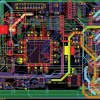Understanding Common Causes of PCB Defects
May 23, 2024
Understanding Common Causes of PCB Defects
During the design and production of PCBs, various issues can arise, such as short circuits, dark spots, grainy connections, and board warping. Let's explore some common causes of these defects.
PCB Short Circuits
This is a common issue that directly prevents PCBs from functioning. Here are some key causes:
1.Improper Pad Design: The primary cause is poor pad design. Changing circular pads to oval ones increases the distance between points, reducing the risk of short circuits.
2.Incorrect Component Orientation: Poor orientation of components like SOICs can cause short circuits. Aligning them perpendicular to the solder wave can prevent this issue.
3.Automatic Insertion Lead Issues: Short circuits can occur if lead lengths are below 2mm and angles are too steep. Ensuring solder points are more than 2mm apart can mitigate this.
Other causes include oversized substrate holes, low soldering temperatures, poor solderability, solder mask failure, and surface contamination. Engineers should investigate these factors to troubleshoot and resolve short circuit issues.

PCB Open Circuits
An open circuit occurs when a trace breaks or solder is only on the pad, not connecting to the component lead. This results in no connection between the component and the PCB. Similar to short circuits, open circuits can happen during production, soldering, or other operations. Mechanical stress like vibration, stretching, dropping, or other deformations can break traces or solder joints. Additionally, chemicals or moisture can corrode solder or metal parts, leading to component lead breakage.

Recent Posts

October 26, 2016
The Most Successful Engineering Contractor
May 12, 2025
China PCB Drilling Routing machine Development
May 06, 2025
PCB Design Process and Key Points





